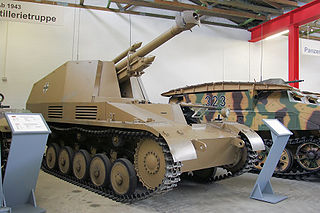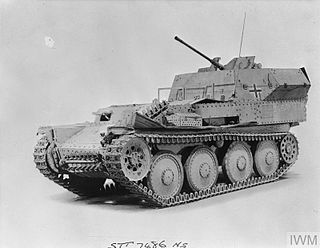
The Panzer II is the common name used for a family of German tanks used in World War II. The official German designation was Panzerkampfwagen II.

The Panzerkampfwagen III, commonly known as the Panzer III, was a medium tank developed in the 1930s by Germany, and was used extensively in World War II. The official German ordnance designation was Sd.Kfz. 141. It was intended to fight other armoured fighting vehicles and serve alongside and support the similar Panzer IV, which was originally designed for infantry support.

The Panzerkampfwagen IV, commonly known as the Panzer IV, is a German medium tank developed in the late 1930s and used extensively during the Second World War. Its ordnance inventory designation was Sd.Kfz. 161.

This article lists production figures for German armored fighting vehicles during the World War II era. Vehicles include tanks, self-propelled artillery, assault guns and tank destroyers.

The Jagdpanzer 38, originally the Leichter Panzerjäger 38(t), known mostly post-war as Hetzer, was a German light tank destroyer of the Second World War based on a modified Czechoslovakian Panzer 38(t) chassis.

The Flakpanzer IV "Wirbelwind" was a German self-propelled anti-aircraft gun based on the Panzer IV tank. It was developed in 1944 as a successor to the earlier Möbelwagen self-propelled anti-aircraft gun.

The Flakpanzer IV "Ostwind" was a German self-propelled anti-aircraft gun based on the Panzer IV tank. It was developed in 1944 as a successor to the earlier Flakpanzer IV/2 cm VierlingWirbelwind.

The 3.7 cm Flak auf Fahrgestell Panzerkampfwagen IV (sf), nicknamed Möbelwagen because of its boxy shape, was a self-propelled anti-aircraft gun built from the chassis of the Panzer IV tank. It was used by the Wehrmacht in the European Theatre of World War II.

The Sd.Kfz. 124 Wespe, also known as Leichte Feldhaubitze 18/2 auf Fahrgestell Panzerkampfwagen II (Sf.), is a German self-propelled gun developed and used during the Second World War. It was based on a modified Panzer II chassis.

Nazi Germany developed numerous tank designs used in World War II. In addition to domestic designs, Germany also used various captured and foreign-built tanks.

The Flakpanzer IV Kugelblitz was a German self-propelled anti-aircraft gun developed during World War II. By the end of the war, only a pilot production of five units had been completed. Unlike earlier self-propelled anti-aircraft guns, it had a fully enclosed, rotating turret.

The German Panzerkampfwagen Neubaufahrzeug, abbreviated as PzKpfw Nb.Fz, series of tank prototypes were a first attempt to create a medium tank for the Wehrmacht after Adolf Hitler had come to power. Multi-turreted, heavy and slow, they were not considered successful, which led to only five being produced. These were primarily used for propaganda purposes and training, though three took part in the Battle of Norway in 1940. Pictures of the Neubaufahrzeuge were displayed with different turret models and orientations to fool allied spies; American and Soviet agents independently reported that the Germans had two new heavy tanks, the Panzer V and VI. In reality, these tanks were far from the Panzer V Panther and the Panzer VI Tiger.

The Flakpanzer 38(t), officially named Flakpanzer 38(t) auf Selbstfahrlafette 38(t) Ausf M , was a German self-propelled anti-aircraft gun used in World War II. It is sometimes incorrectly referred to as the Gepard, which may lead to confusion with the unrelated Flakpanzer Gepard.
The Panzerkampfwagen I was a light tank produced in Germany in the 1930s. The Panzer I was built in several variants and was the basis for a number of variants listed below.

The 12.8 cm Selbstfahrlafette auf VK 30.01(H) "Sturer Emil", also called Panzer Selbstfahrlafette V, was an experimental World War II German self-propelled anti-fortification gun. It was based on the Henschel VK 30.01 (H) chassis and armed with a Rheinmetall 12.8 cm Kanone 40 L/61 gun. This gun could traverse 7° to each side, elevate 10° and depress -15°. It carried 15 rounds for the main gun.
The 8.8 cm Flak 18 (Sfl.) auf Zugkraftwagen 12t , also known as the Bunkerflak or Bufla, was a German Wehrmacht half-track self-propelled gun developed before World War II and used in the first half of the war. It was used during the Invasion of Poland but is best known for its use during the Battle of France, where it was the only German self-propelled gun capable of destroying the heavier Allied tanks such as the French Char B1 and the British Matilda II. Remaining vehicles were used on the Eastern Front. The last Bufla was destroyed in 1943.

The Panzerkampfwagen II Ausf. L "Luchs" is a German light tank from the Second World War, developed between 1940 and 1942 by Daimler-Benz and MAN. The Luchs was the only Panzer II design with the Schachtellaufwerk overlapping/interleaved road wheels and "slack track" configuration to enter series production, with 100 being built from September 1943 to January 1944 in addition to the conversion of the four Ausf. M tanks. Originally given the experimental designation VK 13.03, it was adopted under the alternate name Panzerspähwagen II and given the popular name Luchs. The Luchs was larger than the Panzer II Ausf. G in most dimensions. With a six speed transmission, it could reach a speed of 60 km/h (37 mph) with a range of 260 km (160 mi). The FuG 12 and FuG Spr radios were installed, while 330 rounds of 20 mm and 2,250 rounds of 7.92 mm ammunition were carried.
















